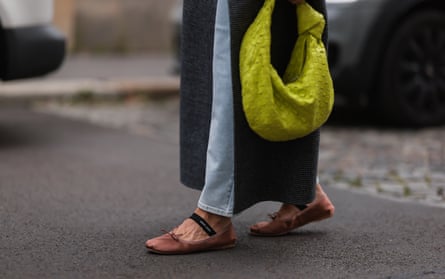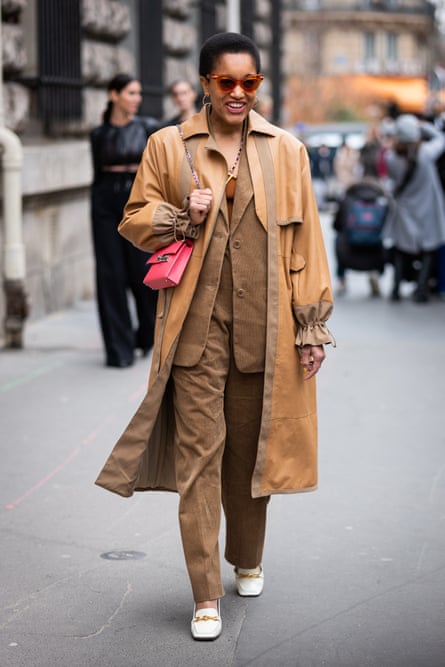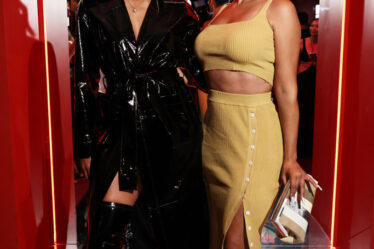
I own a pair of studded red boots that used to make me extremely happy. Then, the other day, when I tried them on for the first time in years, I winced. I saw in them a microcosm of what can happen with your whole wardrobe: the clothes you once loved and wore to death suddenly feel very wrong.
I would wager that there are few people who don’t recognise this feeling. Whether you care about clothes or not, it doesn’t really matter. Certain clothes will still feel comfortable and right while others will not. And because clothes are like our second skin, when they don’t feel right, it can be strange, discombobulating; itchy, almost.
It is a feeling that can be brought on by the big stuff: ageing, babies, grief. Or by something lesser, such as funky weather. It can be about a changing body or an identity in flux. It was also the subject of a recent newsletter from Substack and cool-kid favourite Blackbird Spyplane, in which a subscriber had asked: “How do you regrow your style? Everything I put together right now doesn’t feel like me!”
What do you do when this feeling creeps up on you, or hits you without warning?
Before doing anything rash, consider what might have changed
“It happens to the best of us,” says stylist Sarah Corbett-Winder, who last experienced this after having her third child. “I felt I couldn’t relate and didn’t want to be the person who wore my wardrobe.” But, she cautions: “I also get it if I’m in a ‘negative’ headspace. We can take things out on our clothes as they can’t answer back.”
Grace Snell, the costume designer for the television comedy drama series I Hate Suzie, recently experienced the feeling after surgery. Pulling out all the clothes that she still loves, and putting them on a separate rail has been helpful. “I could see the gaps I needed to buy [clothes for]. I packed up all the other clothes and put them in the loft. Making space for your favourite clothes is the single most important thing.”
Changing the surroundings of your wardrobe will, she says, “help you get a new perspective … I take clothes out of my wardrobe, out of my bedroom and look at them in the lounge, hanging them up around the room.” When you do it, she says: “Make sure you have a good light.”
Think evolution, not revolution
“We often feel we need a drastic change, but actually we need a slow and careful change to our wardrobe. One piece at a time,” says Snell.
Melanie Wilkinson, Guardian style editor, agrees. She suggests focusing on things you already own, such as a white T-shirt, jeans and accessories. “Look at how you can rework them in your new situation/new decade,” she says, suggesting slight tweaks may be all that is needed. “Maybe your shirt becomes an overshirt that you can wear over a dress, or you can tie it at the front over a vest top with some tailored trousers.”
Similarly, Corbett-Winder suggests: “Really think about how you are putting things together. Don’t try to be too clever – go back to basics and keep it simple.”
Dress from a fixed point – think out, or up
Blackbird Spyplane suggests you dress from the cuff out, a technique it calls “cuff stacking”, which it says is ideal for spring when layering is key. What it means is looking at your cuffs and working your way out with each sleeve. It illustrates what it means with a picture of the brown cuff of a hoodie worn over the beige cuff of a mohair jumper stacked with the purple cuffs of a jacket.
For editor and stylist Simon Chilvers, his fixed point is his feet. A new shoe, he says, “can make the hems of your trousers, the turnups on your jeans, or your socks feel a total disaster”. He thinks “starting from the bottom up is worth considering as a wardrobe technique”.

I agree. I’ve had some fun getting dressed by choosing socks first. A pair of bright orange ones recently led me to wear a red jumper that I had forgotten – an outfit that felt good and clashed cheerfully, with a pair of neutral blue jeans.
Snell’s starting point is pants. “With actors we always start with the underwear,” she says. This is where the feeling of confidence in your clothes meets comfort; there is a big overlap. With underwear, she generally sizes up: “Once you feel comfortable, you can build from there.” As someone who, while pregnant, revelled in underwear that now reaches my sternum, and never felt better, I concur.

Think outside the box
When you are ready for some movement, it is worth looking beyond what you would normally wear. “Have a few style heroes in mind,” says Toni-Blaze Ibekwe, editor-in-chief of Wonderland magazine. “And it sounds extra, but vision-board your style the same way you vision-board life goals.
Snell says: “I love to look at photos of my mum and aunty when they were my age. Your clothes should feel timeless – that’s why classic, staple pieces will never age.”
Chilvers counsels looking at “paintings or movies and just spending a day in a city people-watching. “Who do you think looks good in their clothes? Are there things they wear or style in a certain way that would help you to push yourself out of the rut?”
Sometimes, the best people to turn to might be those who dress nothing like you. Looking at the dancer Pina Bausch’s chic, masculine tailoring has helped me in the past, particularly when I have wanted to add a smidgeon of professionalism to a wardrobe that felt too teenage.
Get organised – and get ironing
“Get matching hangers,” says Snell. “Don’t overcrowd your rails. Pack away your summer clothes in winter. Pack away your winter clothes in summer.”
A lot can also be said for taking good care of your clothes: it’s a no-brainer that an unwashed shirt crumpled at the back of your wardrobe won’t feel right. “When designing a show, we have to treat clothes with a lot of respect … By giving time to a garment, it’s amazing how much you grow to respect it.” You may well find old clothes suddenly instilled with new life after a quick iron.
Don’t look back
“The idea of an age-related wardrobe rut has always made me want to eye-roll myself to death,” says Chilvers. “But I can see how it happens. Our body shapes and mindsets change as we age.”
“Keep in mind the elements of your wardrobe that you have always embraced,” agrees Wilkinson. For her, it is the baseball cap. “I’ve just turned 40 and have felt the need to veer more on the side of smart than super-casual.” Instead of jeans, she now wears “a couple of chic, good-quality caps” with tailored trousers and a light knit. “With some clever tailoring, I’ve managed to move it into a new decade.”
Corbett-Winder suggests simply “being honest with yourself”. Maybe that lime green miniskirt you had when you were 15 doesn’t make you feel your best any more. My equivalent is any pair of heels, something I haven’t bought in a decade (on the odd occasion when I pop them on, I feel as if I’m cosplaying a younger version of myself – and not in a good way).
Of course, if you still feel great in the exact get-up you wore five or 40 years ago, then ignore everything you have just read and be happy.



